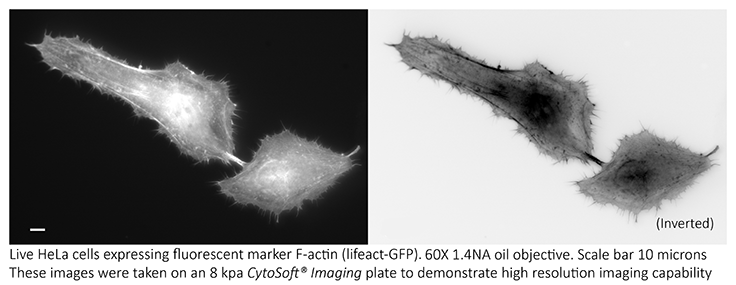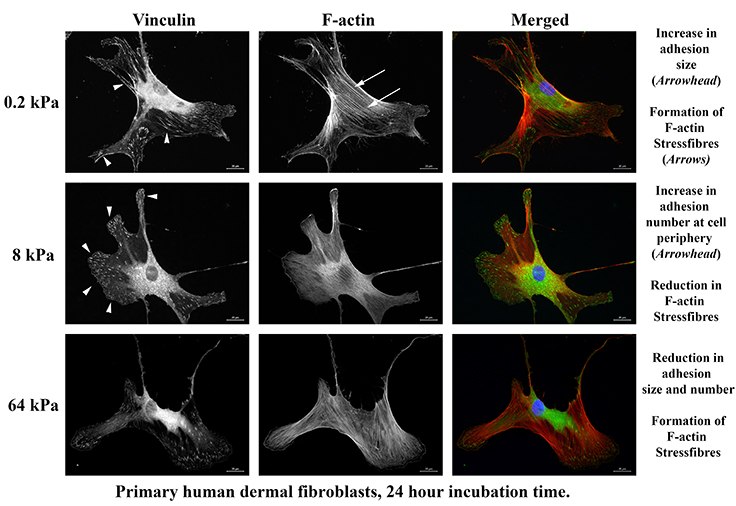CytoSoft® Modulus Plates for Cell Culture
- What is the Elastic Modulus?
- Elastic Modality Importance in Cell Culture
- CytoSoft® Elastic Modulus Plates
- Product Table
What is the Elastic Modulus?
Young’s elastic modulus is the mechanical property that measures the stiffness of a material and is expressed in kilopascals of pressure (kPa). Cells interact with their local 3D microenvironments and reside in different matrix stiffnesses throughout the body, which varies based on tissue location or disease state.
Mechanotransduction is the processes through which cells sense and respond to mechanical stimuli. Cells convert the mechanical stimuli to biochemical signals that then elicit specific cellular responses. Mechanical force and regulatory signals are transmitted from the extracellular matrix (ECM) to the cell through focal adhesions, which are large macromolecular assemblies on the outside of the cell.
Elastic Modality Importance in Cell Culture
Human tissues and organs have low elastic modulus values that range from 0.2 to 64 kPa, whereas tissue cultureware has a much higher elastic modulus of 1x107 kPa. To create more relevant in vitro cell models, researchers have started to cultivate their cells on softer 3D hydrogels and substrates that more closely represent native tissue rigidities. For example, changing to a stiffer substrate alters the differentiation potential of human mesenchymal stem cells to favor bone formation over cartilage and adipose tissues1.

Figure 1. Native matrix stiffnesses of various in vivo tissues.
CytoSoft® Elastic Modulus Plates
An innovative tool to analyze the effect of matrix stiffness and rigidity on regulating cellular behavior, CytoSoft® elastic modulus plates are used to culture cells on substrates with various defined rigidities covering a broad physiological range (0.2kPA- 64kPa). On the bottom of each well, there is a thin layer of specially formulated biocompatible silicone, whose elastic modulus (rigidity) is carefully measured. The surfaces of the gels in CytoSoft® products are functionalized to form covalent bonds with amines on proteins. This chemical functionalization is stable and the reaction does not require a catalyst, facilitating the coating of the gel surfaces with matrix proteins and plating cells. For example, coating with an ECM protein, such as PureCol® (5006), is recommended before plating cells.

Figure 2. Fluorescent cell imaging of F-actin in HeLa cells using CytoSoft® imaging plates (8 kPA).Cell migration and adhesion can be analyzed by monitoring the expression of F-actin filamentous cytoskeleton protein.
The silicone substrates of CytoSoft® plates are optically clear and have a low auto-florescence. The layer of silicone in each well is firmly bonded to the bottom of the well. Unlike hydrogels (such as polyacrylamide gels), silicone gels are not susceptible to hydrolysis, do not dry nor swell, are resilient and resistant to tearing or cracking, and their elastic moduli (rigidities) remain nearly unchanged during extended storage periods.
CytoSoft® products accommodate the harvesting of cells using enzymes such as trypsin and collagenase. There is no biochemical breakdown of the substrate during or after enzyme treatment, and there are no residuals of the substrate in the sample retrieved from a CytoSoft® plate.
For researchers who are unsure which CytoSoft® plate stiffness to use, we offer a Discovery Kit (5190). This kit contains various elastic moduli, including 0.2, 0.5, 2, 8, 16, 32 and 64 kPa in seven individual 6-well plates. Once the elastic modulus is determined, CytoSoft® Imaging plates can be selected. CytoSoft® Imaging plates have low autofluorescence and high optical clarity making them ideal for high-resolution imaging and live cell imaging.

Figure 3. Primary human dermal fibroblast matrix stiffness optimization.A elastic modulus of 8 kPA is an optimal matrix stiffness for dermal fibroblasts showing a reduction in F-actin stress fibers and increased cell adhesion (Vinculin) when compared with 0.2 or 64 kPa matrix stiffnesses.
Materials
References
To continue reading please sign in or create an account.
Don't Have An Account?